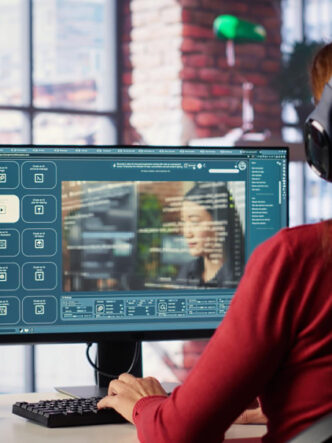Employee training in remote and hybrid work environments introduces both challenges and opportunities. A shift to remote work was necessary during the pandemic and accelerated its adoption. Since then, many companies have continued to allow employees to work remotely. Hybrid work arrangements with a mix of in-person and remote work are also popular. A new way of working requires some rethinking about strategies for employee training and development.

Section 1: Challenges of training remote employees
Employee training for remote teams can present a number of challenges.
Technology hurdles: Remote training can suffer due to internet problems, outdated hardware or software, and the need to learn how to use certain tools.
Lack of engagement: A lack of opportunities for in-person interaction can make it hard to feel connected and engaged when working remotely.
Scheduling obstacles: Getting employees together for live streaming of training can be difficult when they work in different locations and time zones. It can also be challenging to coordinate employees for hybrid workplace training when employees only come into the office on certain days.
Measuring effectiveness: In a traditional training setting, trainers can monitor progress and help individuals who fall behind. Measuring progress is harder when employees are learning remotely.
Section 2: Best practices for remote and hybrid employee training
The following best practices and actionable tips can help you to overcome the challenges of remote learning.
Communicate consistently: Good communication is essential or employees can experience misunderstandings and confusion. Regularly checking in with employees gives them the opportunity to talk about their progress, ask questions, and stay on track.
Promote active learning: Passive consumption doesn’t lead to deep understanding. You need active engagement to reinforce learning. In a virtual environment, the use of interactive quizzes, polls, etc. can facilitate active learning and engagement. You can ask employees to respond to real-life scenarios so they know how to apply their knowledge.
Gather feedback: This is an essential part of learning. It helps to identify gaps, reinforces what employees already know, and shows them where to focus. AI-driven platforms can give employees immediate feedback on their performance. Real-time feedback can come with recommendations for improvement.
Employ micro-learning: Learning can be more effective when it comes in bite-sized, micro-modules. This allows employees to retain information better and prevents cognitive overload.
Allow employees to learn at their own pace: You can accommodate employees by offering them the chance to log in and learn when it suits them. They can access training content in their downtime when they can give it their full attention.
Build on prior knowledge: Employees are able to assimilate new information more easily when they can connect it to what they already know. It helps to give them a step-by-step growth path where they can progress from simple to more complex training.
Cultivate a sense of community: You can cultivate a sense of team and community when training remote and hybrid employees. For example, you can schedule some online discussions. It gives employees an opportunity to get together virtually and learn from one another. You can use video messaging so employees can ask questions and get answers about training content.
Measure results: Collecting metrics helps you to measure the success of your training. In an LMS you can see performance on quizzes and course completion rates. If you see where your employees struggle to understand content or lose interest, you can make improvements in the course content.

Section 3: Leveraging technology to facilitate remote learning
Selecting the right platform is critical for training success. You need a platform that can accommodate many forms of media to make learning more engaging. Cincopa is a multi-media hosting platform where you can upload, manage, and embed images, videos, and podcasts.
The ongoing innovation in video platforms, team communication apps, and task management tools can help remote teams to be more efficient. They can use tools from chat in Zoom to collaborative group working spaces.
Cincopa offers live streaming of webinars directly from your account and encourages team collaboration. CincoTube allows for the creation of access-restricted channels for secure internal communication. You can centralize your video assets with shared media libraries for easy access to training materials.
It shouldn’t matter what devices employees use to watch training videos. They should be mobile responsive and offer lag-free video playback. Cincopa’s content delivery network (CDN) means viewers can get video content from a distributed set of services that caches content nearest to them. This improves video load times and performance.
A clear link to a technical guide can help remote employees to troubleshoot common technical problems. Employees should also be able to reach live tech support when necessary.
Section 4: Keeping remote teams engaged and accountable
You need to find ways to counteract the disengagement and isolation that can come when working remotely. Investing in the right strategies can help you to keep teams engaged and accountable.
Create a development framework: You need to promote remote employee development. Every employee should know what they need to learn to reach the next level. A practical way to ensure they learn in an organized way is with access to a linear playlist of videos on a specific topic.
Have regular check-ins: Setting up regular check-ins helps to ensure employees are on track with their training. This can be in the form of weekly video chats.
Use employee surveys: You can ask employees directly how they are progressing by using surveys with open-ended questions. For example, you can ask them what further support they need.
Use video messaging: Using video messaging tools for even brief interactions can make a difference in productivity and morale.
Establish feedback loops: Your employees need to become comfortable with giving and receiving feedback. Besides employee surveys, you can use the tools employees prefer to use to give and receive feedback. Some will prefer to use their mobile devices rather than their desktops. Feedback mechanisms should be dynamic rather than relying on static online suggestion boxes.
Use gamified learning: By incorporating elements such as points, badges, leaderboards, and interactive simulations you can make learning more engaging. These elements create a sense of friendly competition between remote teams and motivate them to participate actively in training. Tapping into the innate human desire for competition and achievement can lead to an increase in knowledge retention.
Find ways to celebrate wins: You can encourage and motivate employees by highlighting their wins, no matter how small. A little recognition, such as a public shoutout on a dedicated Slack team channel can go a long way. You can also offer monetary rewards, non-monetary ones like time off, or special experiences.
Use in-depth analytics: The Cincopa video hosting platform offers in-depth video analytics, including heat maps and dashboards. Heatmaps show how employees engage with videos. You can see where they skip content, rewatch, or drop off. These insights help you to improve your training material.
Conclusion
On Cincopa’s home page, you will immediately see the products, solutions, and resources it has to offer. The platform will help to transform your remote and hybrid training programs. It will make them more accessible, secure, flexible, engaging, and measurable.








